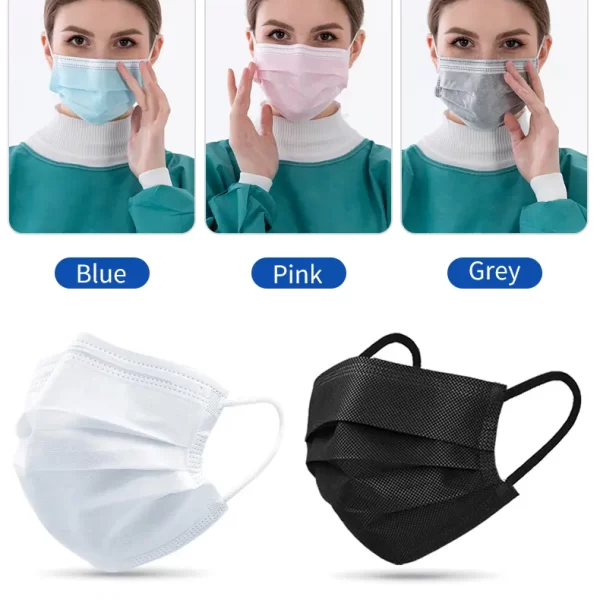Introduction
In an era where health and safety have taken center stage, the 3-ply face mask has emerged as an indispensable shield against airborne diseases. While these masks have become a common sight worldwide, the intricate journey they undertake from production to usage remains largely unexplored. This comprehensive journey not only reveals meticulous processes but also unravels the science and engineering behind this seemingly simple protective tool.
Chapter 1: The Production Phase
Material Selection
The production journey of a 3-ply face mask begins with the careful selection of materials. Each of the mask’s three layers is designed with a specific role, calling for materials with distinct properties.
The Outer Layer: This layer serves as the first barrier against external particles. Made from non-woven polypropylene, this layer exhibits hydrophobic properties, repelling water and other liquid droplets, including those that may carry potential pathogens.
The Middle Layer: Often described as the heart of the mask, this layer is composed of melt-blown fabric. This intricate web of fine fibers acts as a highly effective filter, trapping microscopic particles, including bacteria and viruses, that try to penetrate the mask.
The Inner Layer: This layer is designed to ensure wearer comfort. Made from a soft, absorbent material, it soaks up the moisture from the wearer’s breath, preventing it from reaching the outer layers and maintaining the mask’s integrity during prolonged wear.
Mask Formation
With the right materials in hand, the next step is to form these into the final mask product. This process is achieved through ultrasonic welding, a sophisticated technique that uses high-frequency sound waves to generate heat at specific points between the materials. This heat causes the materials to fuse together, forming the mask’s overall shape, including the pleats and the securement of the ear loops.
Chapter 2: Quality Control and Packaging
Once the masks have been formed, they are not immediately ready for use. They must first undergo rigorous quality control tests. These tests assess various mask performance factors, including:
Filtration Efficiency: This test measures the mask’s ability to filter out microscopic particles. Masks are subjected to aerosols of a specified size, and the proportion that penetrates the mask is measured to determine the filtration efficiency.
Breathability: This test gauges the mask’s breathability by measuring the pressure drop across the mask during breathing, ensuring that the wearer can breathe comfortably while wearing the mask.
Fluid Resistance: This test assesses the mask’s ability to resist the penetration of synthetic blood at various pressure levels, simulating the mask’s protection against blood and body fluid splatters.
Masks that pass these stringent tests are then approved for packaging. It’s essential to ensure that the packaging process is sterile, preventing any contamination before the masks reach the consumers. Masks are typically packaged in sealed plastic or paper boxes, with individual wrapping for more premium products.
Chapter 3: Distribution and Retail
The journey of the 3-ply mask continues as it moves from the production facilities to retailers and medical facilities worldwide. This stage underscores the importance of an efficient logistics system and a reliable supply chain. Given the global demand for 3-ply face masks, maintaining a steady supply flow is crucial. Additionally, the distribution process must ensure the masks are handled hygienically and stored in conditions that preserve their quality.
Chapter 4: The Consumer Phase
When a mask reaches the end-user, the final phase of the journey begins. Here, the onus of ensuring the mask’s effectiveness shifts to the wearer. For the mask to serve its purpose, the wearer must follow specific usage guidelines:
Proper Wearing: The mask must cover the nose, mouth, and chin fully, with no gaps between the face and the mask.
Secure Fitting: The mask should fit securely on the face. Many masks come with a flexible metal strip at the top that can be molded to fit the shape of the wearer’s nose, ensuring a secure fit.
Regular Replacement: Masks should be replaced as soon as they become damp. Most 3-ply masks are designed for single use and should not be reused.
Correct Donning and Doffing: It’s crucial to follow the correct procedure for putting on (donning) and taking off (doffing) the mask to prevent self-contamination. This involves handling the mask only by the ear loops or ties and avoiding touching the mask’s front.
Chapter 5: Disposal of the Mask
The journey of the 3-ply face mask concludes with its disposal. Given the potential for contamination, used masks should be discarded responsibly in a closed bin. As environmental concerns grow, there is increasing emphasis on developing more sustainable alternatives, including reusable masks or masks made from biodegradable materials.
Conclusion
The journey of a 3-ply face mask is a complex process that encompasses careful material selection, meticulous production techniques, stringent quality control, and conscientious usage practices. As we continue to depend on these masks for our health and safety, understanding their journey allows us to appreciate the intricacies involved in their creation and underscores the importance of their proper usage. As we march forward into an uncertain health landscape, the 3-ply face mask will continue to play a crucial role, serving as a testament to human ingenuity and our collective effort to protect one another.
Please visit our website for more product details https://medposnonwoven.com/product/3-ply-civil-face-mask-with-earloop/

